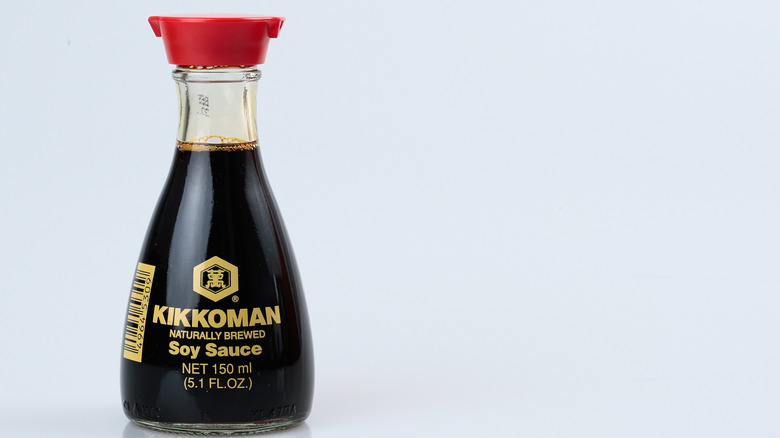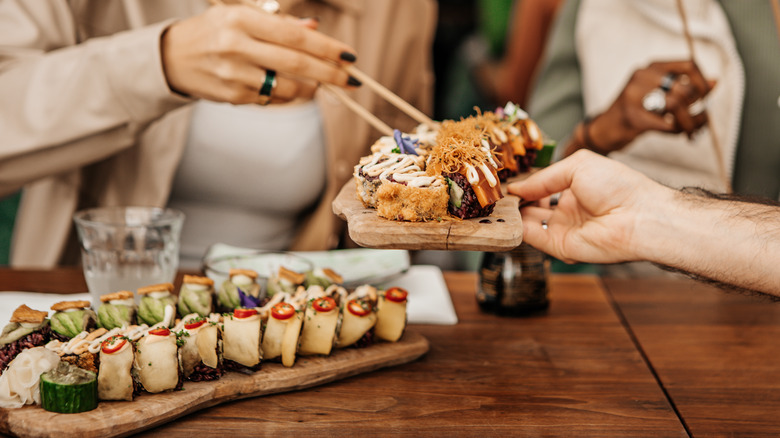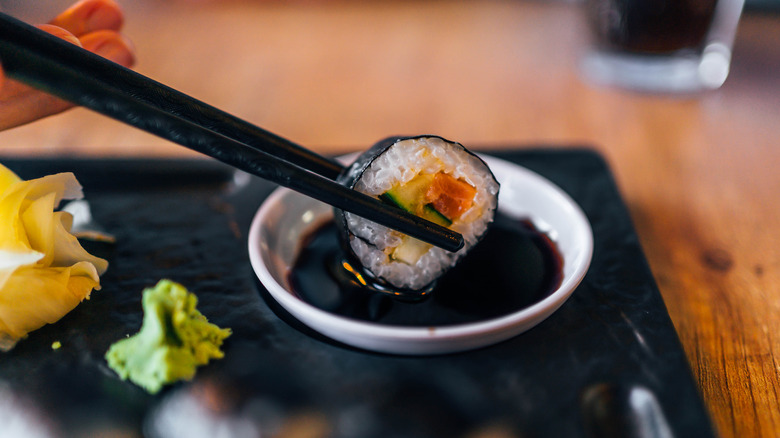There's Actually A Good Reason Your Soy Sauce Bottle Has Two Spouts
Sitting down at your favorite sushi restaurant isn't just a chance to enjoy an exciting meal; it's a ritual. The table is set with chopsticks and their resting trays and small bowls in which pieces of maki, nigiri, or sashimi can take a dip in what many diners consider to be sushi's most critical seasoning — soy sauce.
In many places, the bottle of soy sauce — often produced by Kikkoman — is an iconic element all its own. The Japanese brand is more than a century old, and its dispenser, introduced in 1961, can now be found in more than 100 countries; it even holds a trademark in several of them. The company relies on the shape and look of the bottle — a bulbous body with a narrow, short neck and an orange or green plastic top (the latter indicating lower sodium) — to represent the brand and hopes it invokes memories and nostalgic feelings for those at the table.
For hungry diners, though, it can also spark fear. Anyone who has ever been eager to dive into their dinner may have found themselves in a pool of brown liquid, as the thin sauce can come from the bottle fast and furiously. But if you've noticed and wondered why that Kikkoman bottle has two spouts, it's because they have already given you the solution to this problem. This curious design is intended to slow and stop the flow of soy so you can control your pour.
How those two spouts work together
It couldn't be simpler to use this ingenious design. When you tip the bottle toward your bowl, you release a stream of soy sauce that will come out unimpeded. If you're not super careful, it can quickly create an overflow situation or drown your poor sushi pieces before you have a chance to taste them.
However, if you simply cover one opening with a finger (the one facing the ceiling), you'll be able to slow or even stop the release of sauce from the bottle. In doing so, you're able to actually control how much liquid comes from the dispenser, so you don't wind up with a splashfest all over your sushi-ready table. You can also more deliberately apply sauce directly to your sushi pieces with this method, with the confidence that you'll be able to place a few drops rather than unleashing a tidal wave.
Saucing your sushi
Kikkoman's design helps you steer clear of a total mess, but it's also essential for ensuring an optimal experience. Expert advice for eating sushi is to exercise restraint when it comes to soy sauce. The flavors of your dish are delicate and meticulously crafted by sushi chefs and easily overwhelmed by the potent salty condiment. A few drops should do the trick, and it's best to try to keep your sauce from saturating your rice. Instead, aim to get some soy essence on the nori (the seaweed wrap) when possible. In the case of nigiri sushi, you'll actually want to invert the piece when you dip into a bowl of soy so that the fish — and not the rice — is what gets sauced.
The two-spout system helps you manage your soy-to-sushi goals, but Kikkoman hasn't stopped innovating with its packaging. In 2011, it released a new soy variant—Shoyu Smooth Aromatic — with another particular bottle design. In this case, the double-walled squeeze container is intended to maintain peak freshness by ensuring the sauce isn't exposed to oxygen, as Shoyu Smooth is unpasteurized.
Regardless of your sauce preferences, we can thank the people at Kikkoman for this unique design for enjoying perfectly seasoned sushi. Whether you're working your way through the best sushi restaurants in every state or making a spicy tuna roll at home, you can rest assured you'll have a handle on dispensing your soy sauce.


